 Facebook
Facebook
 X
X
 Instagram
Instagram
 TikTok
TikTok
 Youtube
Youtube
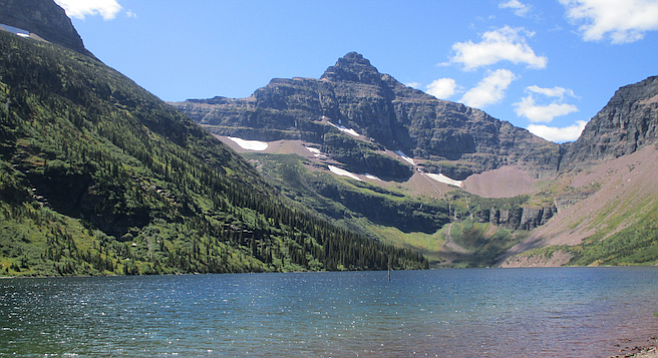
"I have to stay up here all summer and look at this,” our guide mockingly bemoaned while guiding us across exquisite Two Medicine Lake on the eastern side of Glacier National Park. We surveyed the scene along the lake cruise. The still, azure lake and the surrounding, majestic peaks – Lone Walker, Rising Wolf and Sinopah Mountain – presented as glorious a slice of scenery as I had witnessed since visiting Alaska a few years ago.
On this clear, mildly breezy late summer morning, there was no discernible sign of the fires that dominated the news of this area and continued to plague a section of this most beautiful of national parks (outside of Yosemite, in my opinion). The fires are only part of the problem that natural patterns have presented this region. In 1850, there were 150 active glaciers in Glacier National Park. There are now 25 left. Scientists predict that by 2020 some of the park’s largest glaciers will be gone. By 2030, they will all most likely be gone. But it’s possible they may all be gone within a decade, as many of them are receding faster than predicted. Eh, climate change deniers?
Upper Two Medicine Lake resides at an elevation of 5500 feet, the highest of the three lakes in the Two Medicine region. The hike there and back is about five miles through lovely terrain alternating between thick forest and open, elevated vistas. I hiked past twin waterfalls along trails dotted with wildflowers. The hike provides views of a third lake and golden hills in the distance.
Upper Two Medicine Lake finally revealed itself beyond the thickets and an ominous sign warning “You’re entering Grizzly Territory.” I sat down and stared at the lake and hills, just vegetating for over an hour, soaking in the stillness of the scene and immersing myself in the natural beauty of the region. Hey, if a bear gets me, this is not a bad place to meet my maker.
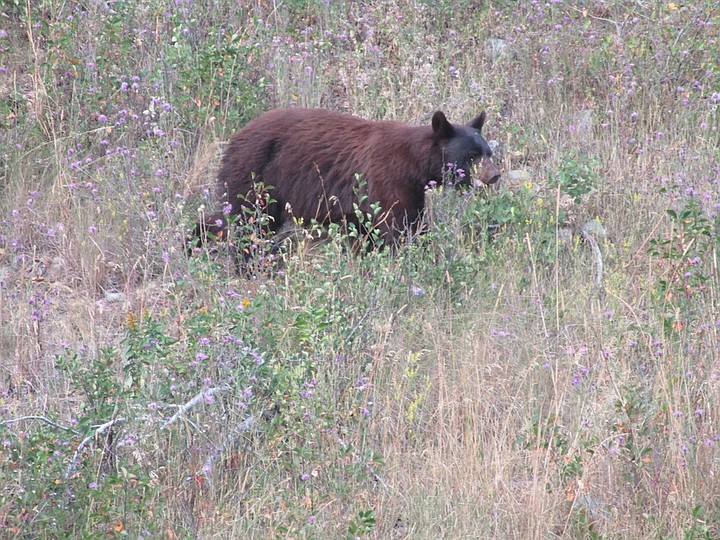
A trio of hikers arrived, breaking the silence with bells strapped to their waists to alert any bears that may be nearby. This is a wise move. When detecting humans, bears prefer to keep their distance. The danger arises when a human surprises a bear. If you plan to do extensive hiking here, it may be worthwhile to bring along some bear spray.
Sidenote: On my last day at Glacier NP, driving along the eastern border of the park, I finally spotted a grizzly to the side of the road enjoying a snack of huckleberries. I watched it for several moments, mesmerized, and wondered what my reaction would be if I had encountered it while hiking.
Some hikers with binoculars spotted some bighorn sheep high up the cliffs near Two Medicine Lake. The goats prefer the precarious mountain ledges to the valley where they are vulnerable to mountain lions. I imagine they have quite the view to savor from up there as well.
Thirteen campgrounds are scattered about Glacier NP. Several guided hikes and ranger-led activities are available during the summer. If you decide to hike alone, it is recommended that you leave a voluntary day trip planner form at your hotel’s front desk. Should an adverse situation arise, park officials could use that to begin a search and rescue.
On the cruise back across Two Medicine Lake, the guide spoke of the reverence and connection the native Blackfeet had with the surrounding land and mountains for scores of generations. Glacier National Park had been inhabited and revered by the Blackfeet for 12,000 years before they were relocated to outlying reservations and communities.
The beauty of the land reinforced the Blackfeet belief that we’re all connected through the land and connected with the Creator. They called Glacier National Park the “backbone of the world.” The land was an integral part of their culture and they had, and still have, an intimately spiritual connection with it. Vision quests were traditionally performed in the Two Medicine region. Unfortunately, the Blackfeet have now been exiled to reservations and communities like economically depressed Browning outside of Glacier NP (where the interested visitor can explore the Museum of the Plains Indian). The park's eastern border is the western border of their reservation. They speak of their lack of access to spiritual sites within the park and traditional holy practices such as praying and fasting for visions.
The prohibition and regulation of some traditional practices within the park’s boundaries has caused tension between the Blackfeet and park officials. Most Blackfeet would like a greater role and inclusion in park management decisions, including access to spiritual sites within the park during certain select times of the year. They often feel as if they are unwelcome visitors when they enter the park, rather than the original inhabitants.
Despite their differences, the Blackfeet support the role of the park service in protecting the park’s resources from further development. The Native America Speaks program offers daily activities and presentations throughout the summer to better provide visitors with a taste of Blackfeet culture. Guided tours through Sun Tours present Glacier NP from the Blackfeet perspective.
McDonald Lodge, situated near the west entrance to the park alongside Lake McDonald, is one of the most famous and historic locations for accommodations in the park. It’s the first stop for many visitors after the visitor’s center. Sunsets and sunrises here along the lake are particularly lovely.
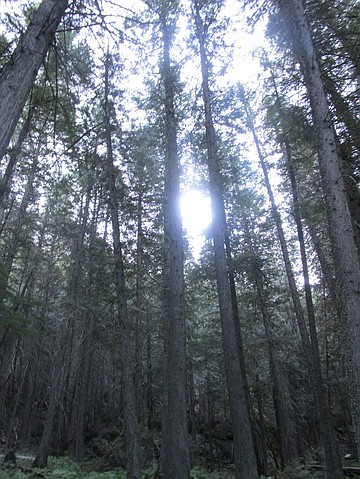
Just past McDonald Lodge on the way to Logan Pass, the Trail of the Cedars is a worthwhile stop for an invigorating short hike. I went early in the morning and encountered only one other hiker on the trail. It was a transcendent experience to be alone with these majestic trees. (This trail is also wheelchair-accessible.)
A helpful tip for prospective visitors: try to make it to Logan Pass by 9 a.m. If you come at 10 or later you may not find a parking spot. You do not, however, want to rush along the engineering marvel which is the Going to the Sun Road. Often called the most spectacular drive in the world, the Going to the Sun route provides several turnouts to let you savor the spectacular scenery. Take advantage of them. Otherwise you may be tempted, as you rise into the mountains, to take your eye off the road to appreciate the expansive valley below. This is not the place to do this.
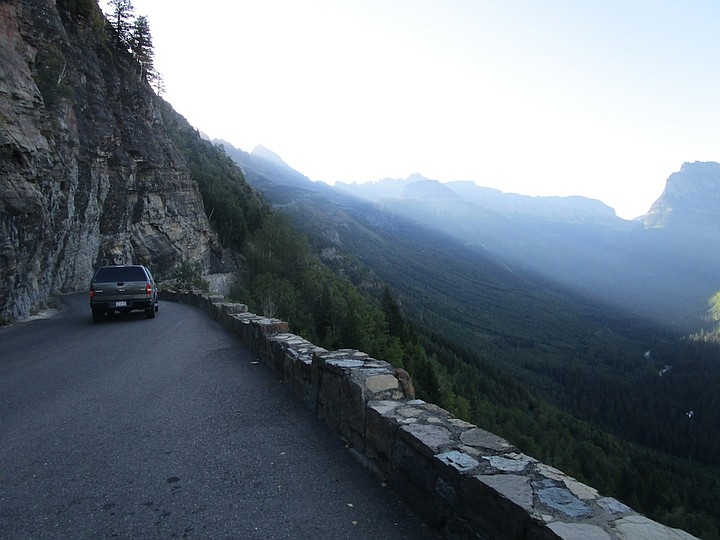
Conversely, you could opt to take one of the famous park Red Jammer buses and focus on the scenery instead of the road. There are also free park shuttles that can deliver you to selected spots in the park. They tend to fill up quickly, though, in which case you will need to wait for the next shuttle – so it’s important to plan accordingly.
A recommended hike near Logan Pass is the Highline Trail, which runs along the side of a mountain and offers a spectacular view of the valley.
I drove the length of the Going to the Sun highway the first day it was reopened east of Logan Pass after closure due to the fire. We were not allowed to stop at the turnoffs east of Logan Pass, but I held my phone out the window to record some of the effects of the fire. The trees surrounding St. Mary’s Lake were clearly charred, and I could only imagine the loveliness of the terrain beforehand.
After a lengthy drive from Logan Pass I arrived at Many Glacier Hotel, the most popular and historic resort in the park, just in time to catch my cruise across the two adjacent lakes, Swiftcurrent Lake and Lake Josephine. The two shuttle boat rides will shave 3.4 miles off the hike to Grinnell Glacier.
But if you have the time, why not do it on foot? The 7.6-mile round trip hike to Grinnell Glacier from Many Glacier Hotel through thick forests of cedar and pine trees, ferns, thimbleberries and huckleberries is one of the best in the park. From the Grinnell Glacier Overlook you can savor panoramic views of the 152-acre glacier, Upper Grinnell Lake, the Garden Wall (Continental Divide), as well as Mount Gould.
This year, Many Glacier Hotel celebrates its 100th anniversary. The scenic vista it offers featuring Swiftcurrent Lake and Mount Gould in the distance would be difficult for any other hotel to match. Those who don’t care for hiking can just lounge on the hotel deck and savor the view. “Jack Nicholson loves to stay here in the winter,” I was told.
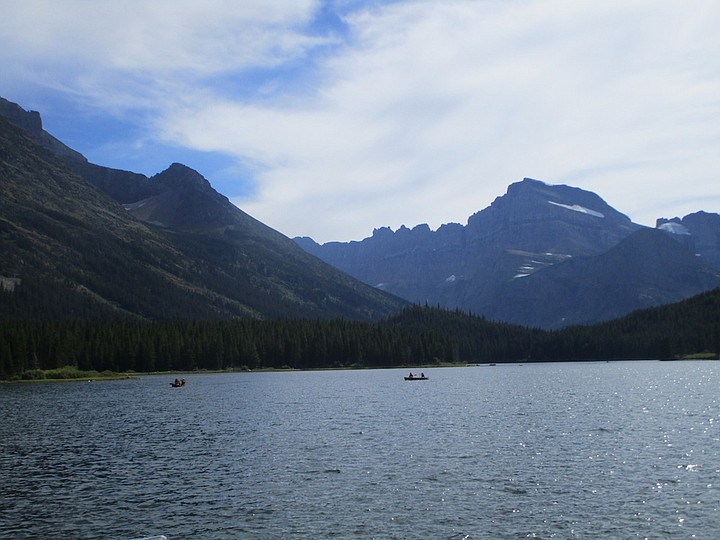
As our cruise boat leisurely made its way across the lake, someone swore he saw a bear swimming in the lake at a distance. Don’t know if that was legit, but I suspect that bear mirage sightings are a common park occurrence.
While disembarking from the boat on the return cruise to the hotel, I took one final gaze across Swiftcurrent Lake. A smattering of kayakers drifted lazily, seemingly without a care in the world. I reluctantly turned back to my rental car.
Check out Derek's e-book How to Travel On the Cheap (...and Even for Free!): Turn Your Travel Dreams Into Reality, available in the Amazon Kindle store.


"I have to stay up here all summer and look at this,” our guide mockingly bemoaned while guiding us across exquisite Two Medicine Lake on the eastern side of Glacier National Park. We surveyed the scene along the lake cruise. The still, azure lake and the surrounding, majestic peaks – Lone Walker, Rising Wolf and Sinopah Mountain – presented as glorious a slice of scenery as I had witnessed since visiting Alaska a few years ago.
On this clear, mildly breezy late summer morning, there was no discernible sign of the fires that dominated the news of this area and continued to plague a section of this most beautiful of national parks (outside of Yosemite, in my opinion). The fires are only part of the problem that natural patterns have presented this region. In 1850, there were 150 active glaciers in Glacier National Park. There are now 25 left. Scientists predict that by 2020 some of the park’s largest glaciers will be gone. By 2030, they will all most likely be gone. But it’s possible they may all be gone within a decade, as many of them are receding faster than predicted. Eh, climate change deniers?
Upper Two Medicine Lake resides at an elevation of 5500 feet, the highest of the three lakes in the Two Medicine region. The hike there and back is about five miles through lovely terrain alternating between thick forest and open, elevated vistas. I hiked past twin waterfalls along trails dotted with wildflowers. The hike provides views of a third lake and golden hills in the distance.
Upper Two Medicine Lake finally revealed itself beyond the thickets and an ominous sign warning “You’re entering Grizzly Territory.” I sat down and stared at the lake and hills, just vegetating for over an hour, soaking in the stillness of the scene and immersing myself in the natural beauty of the region. Hey, if a bear gets me, this is not a bad place to meet my maker.

A trio of hikers arrived, breaking the silence with bells strapped to their waists to alert any bears that may be nearby. This is a wise move. When detecting humans, bears prefer to keep their distance. The danger arises when a human surprises a bear. If you plan to do extensive hiking here, it may be worthwhile to bring along some bear spray.
Sidenote: On my last day at Glacier NP, driving along the eastern border of the park, I finally spotted a grizzly to the side of the road enjoying a snack of huckleberries. I watched it for several moments, mesmerized, and wondered what my reaction would be if I had encountered it while hiking.
Some hikers with binoculars spotted some bighorn sheep high up the cliffs near Two Medicine Lake. The goats prefer the precarious mountain ledges to the valley where they are vulnerable to mountain lions. I imagine they have quite the view to savor from up there as well.
Thirteen campgrounds are scattered about Glacier NP. Several guided hikes and ranger-led activities are available during the summer. If you decide to hike alone, it is recommended that you leave a voluntary day trip planner form at your hotel’s front desk. Should an adverse situation arise, park officials could use that to begin a search and rescue.
On the cruise back across Two Medicine Lake, the guide spoke of the reverence and connection the native Blackfeet had with the surrounding land and mountains for scores of generations. Glacier National Park had been inhabited and revered by the Blackfeet for 12,000 years before they were relocated to outlying reservations and communities.
The beauty of the land reinforced the Blackfeet belief that we’re all connected through the land and connected with the Creator. They called Glacier National Park the “backbone of the world.” The land was an integral part of their culture and they had, and still have, an intimately spiritual connection with it. Vision quests were traditionally performed in the Two Medicine region. Unfortunately, the Blackfeet have now been exiled to reservations and communities like economically depressed Browning outside of Glacier NP (where the interested visitor can explore the Museum of the Plains Indian). The park's eastern border is the western border of their reservation. They speak of their lack of access to spiritual sites within the park and traditional holy practices such as praying and fasting for visions.
The prohibition and regulation of some traditional practices within the park’s boundaries has caused tension between the Blackfeet and park officials. Most Blackfeet would like a greater role and inclusion in park management decisions, including access to spiritual sites within the park during certain select times of the year. They often feel as if they are unwelcome visitors when they enter the park, rather than the original inhabitants.
Despite their differences, the Blackfeet support the role of the park service in protecting the park’s resources from further development. The Native America Speaks program offers daily activities and presentations throughout the summer to better provide visitors with a taste of Blackfeet culture. Guided tours through Sun Tours present Glacier NP from the Blackfeet perspective.
McDonald Lodge, situated near the west entrance to the park alongside Lake McDonald, is one of the most famous and historic locations for accommodations in the park. It’s the first stop for many visitors after the visitor’s center. Sunsets and sunrises here along the lake are particularly lovely.

Just past McDonald Lodge on the way to Logan Pass, the Trail of the Cedars is a worthwhile stop for an invigorating short hike. I went early in the morning and encountered only one other hiker on the trail. It was a transcendent experience to be alone with these majestic trees. (This trail is also wheelchair-accessible.)
A helpful tip for prospective visitors: try to make it to Logan Pass by 9 a.m. If you come at 10 or later you may not find a parking spot. You do not, however, want to rush along the engineering marvel which is the Going to the Sun Road. Often called the most spectacular drive in the world, the Going to the Sun route provides several turnouts to let you savor the spectacular scenery. Take advantage of them. Otherwise you may be tempted, as you rise into the mountains, to take your eye off the road to appreciate the expansive valley below. This is not the place to do this.

Conversely, you could opt to take one of the famous park Red Jammer buses and focus on the scenery instead of the road. There are also free park shuttles that can deliver you to selected spots in the park. They tend to fill up quickly, though, in which case you will need to wait for the next shuttle – so it’s important to plan accordingly.
A recommended hike near Logan Pass is the Highline Trail, which runs along the side of a mountain and offers a spectacular view of the valley.
I drove the length of the Going to the Sun highway the first day it was reopened east of Logan Pass after closure due to the fire. We were not allowed to stop at the turnoffs east of Logan Pass, but I held my phone out the window to record some of the effects of the fire. The trees surrounding St. Mary’s Lake were clearly charred, and I could only imagine the loveliness of the terrain beforehand.
After a lengthy drive from Logan Pass I arrived at Many Glacier Hotel, the most popular and historic resort in the park, just in time to catch my cruise across the two adjacent lakes, Swiftcurrent Lake and Lake Josephine. The two shuttle boat rides will shave 3.4 miles off the hike to Grinnell Glacier.
But if you have the time, why not do it on foot? The 7.6-mile round trip hike to Grinnell Glacier from Many Glacier Hotel through thick forests of cedar and pine trees, ferns, thimbleberries and huckleberries is one of the best in the park. From the Grinnell Glacier Overlook you can savor panoramic views of the 152-acre glacier, Upper Grinnell Lake, the Garden Wall (Continental Divide), as well as Mount Gould.
This year, Many Glacier Hotel celebrates its 100th anniversary. The scenic vista it offers featuring Swiftcurrent Lake and Mount Gould in the distance would be difficult for any other hotel to match. Those who don’t care for hiking can just lounge on the hotel deck and savor the view. “Jack Nicholson loves to stay here in the winter,” I was told.

As our cruise boat leisurely made its way across the lake, someone swore he saw a bear swimming in the lake at a distance. Don’t know if that was legit, but I suspect that bear mirage sightings are a common park occurrence.
While disembarking from the boat on the return cruise to the hotel, I took one final gaze across Swiftcurrent Lake. A smattering of kayakers drifted lazily, seemingly without a care in the world. I reluctantly turned back to my rental car.
Check out Derek's e-book How to Travel On the Cheap (...and Even for Free!): Turn Your Travel Dreams Into Reality, available in the Amazon Kindle store.
Comments